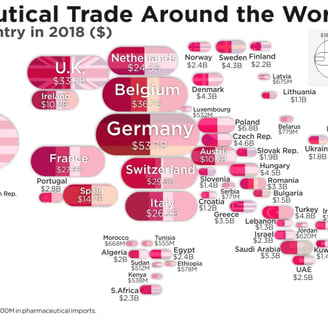Global Pharma Dynamics: The Balance Between Production and Consumption
12/2/20243 min read


The global pharmaceutical industry, valued at a staggering $3.67 trillion, is a vital pillar of the world economy. With life-saving drugs, cutting-edge research, and revolutionary healthcare solutions at its core, the sector showcases a fascinating interplay between production and consumption. However, not all countries contribute equally—some dominate as producers, while others are voracious consumers.
Let’s delve into the dynamics of the top pharmaceutical players and uncover some surprising insights.
1. The Big Players: Who Produces and Who Consumes?
While the United States leads the world in pharmaceutical consumption, other countries like Germany, Switzerland, and Ireland dominate production and exports. Here’s a closer look:
Top Producers (Exports)
Ireland: A pharma manufacturing powerhouse, responsible for ~7% of global exports. Despite this, its domestic market is negligible, with most production serving multinational corporations.
Switzerland: Renowned for high-margin, innovative drugs from companies like Novartis and Roche, Switzerland exports ~9% of global pharmaceuticals.
India: The "Pharmacy of the World," India specializes in generics, exporting ~10% of global pharma, but its domestic consumption remains low.
China: A leader in exporting APIs (active pharmaceutical ingredients), China balances significant domestic consumption with ~12% of global exports.
Top Consumers
United States: Accounting for 40-45% of global pharma consumption, the U.S. relies heavily on imports to meet demand. High healthcare spending and advanced drug pricing mechanisms make it the largest single market.
European Union: Collectively, EU nations consume ~25% of global pharmaceuticals, driven by aging populations and universal healthcare systems.
Japan: With ~7-8% of consumption, Japan focuses on innovative drugs for its aging population.
China: Rapidly growing healthcare access and rising incomes have made China a significant consumer, matching its production capabilities.
2. The Balance Between Exporters and Importers
Net Exporters: Dominating Global Supply
Ireland, Switzerland, Belgium, and Germany export far more than they consume, serving as manufacturing hubs for the world. These countries leverage advanced technologies, favorable tax policies, and skilled workforces to produce high-value drugs for global markets.
Net Importers: Feeding Domestic Demand
The United States and Japan stand out as net importers, consuming more pharmaceuticals than they produce. For the U.S., this is driven by high per capita healthcare spending and reliance on specialized drugs.
3. The Outliers: Surprising Insights
India: Despite being a top producer, India's domestic consumption remains low (~2-3% of the global market). Affordable generics dominate the market, with exports taking center stage.
Ireland: Although responsible for ~7% of global exports, Ireland’s domestic consumption is negligible. Its pharma industry primarily caters to multinational corporations operating in the country.
China: A unique balance—China is both a top producer and consumer, reflecting its growing economic power and expanding healthcare system.
4. Emerging Trends in the Global Pharma Market
The Rise of Generics: India and China dominate the generics market, providing cost-effective alternatives to patented drugs, especially in low- and middle-income countries.
Innovation Hubs: Countries like Switzerland, the U.S., and Japan focus on high-margin, innovative therapies, with significant investment in R&D.
Shift in Consumption: Emerging markets like Brazil, Southeast Asia, and parts of Africa are experiencing growth in pharmaceutical consumption, thanks to rising incomes and better healthcare access.
5. Key Takeaways
The United States is the largest consumer, but it depends heavily on imports, showcasing a clear reliance on global supply chains.
Europe plays a dual role, with countries like Germany and Switzerland balancing significant production and consumption.
India and China are production powerhouses, but their domestic markets differ—China consumes more, while India focuses on exports.
Ireland and Belgium thrive as manufacturing hubs, with minimal domestic consumption but substantial global contributions.
Final Thoughts
The global pharmaceutical industry is a delicate ecosystem of production and consumption, driven by innovation, economics, and healthcare needs. For countries like the United States, dependency on imports underlines the importance of global collaboration, while producers like India and Switzerland demonstrate the power of specialization.
As the industry evolves, emerging markets will play a larger role in both production and consumption, reshaping the dynamics of this critical sector. The question remains—how will these shifts impact global healthcare access, innovation, and affordability?
What do you think about the balance of power in the pharmaceutical industry? Are we moving towards a more equitable distribution, or will a few players continue to dominate? Let’s discuss!
#Pharmaceuticals #GlobalMarket #Healthcare #Innovation #India #USA #China #PharmaTrends
